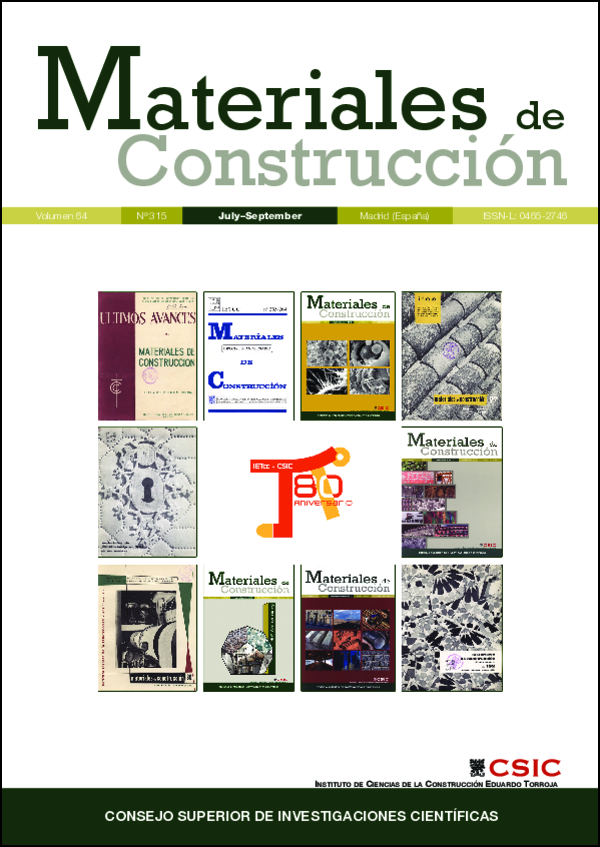Evaluation of the fatigue macro-cracking behavior of crumb rubber modified bituminous mixes
DOI:
https://doi.org/10.3989/mc.2014.07913Keywords:
Asphalt mixes, Crumb rubber, Fatigue cracking, Four-point bending testAbstract
The use of crumb rubber modified bitumen (CRMB) in asphalt mixes is a road engineering technology that has become increasingly important in recent years. Given the many economic and environmental benefits of this type of binder, the goal is to give CRMB the same level of performance as conventional polymer-modified bitumen. The appearance and propagation of cracks due to fatigue phenomena is one of the most common distresses affecting road pavements. Since crumb rubber enhances the mechanical properties of asphalt mixes, it can provide a viable solution for fatigue cracking. This paper presents the results of a comparative analysis of the fatigue-cracking behavior of asphalt mixtures manufactured with crumb rubber modified bitumen and polymer-modified bitumen.
Downloads
References
Colombier, G. (1997) Cracking in pavements: nature and origin of cracks. Prevention of Reflective Cracking in Pavements – RILEM Report 18. Edited by Vanelstraete A. and Franckien L., 1–15.
European Asphalt Pavement Association, EAPA (2012) Asphalt in Figures 2010. <http://www.eapa.org> (Aug. 21, 2012).
Ruiz, A. (2010) Mezclas con caucho de neumáticos. Mezclas Bituminosas: dosificación, fabricación, puesta en obra y control de calidad, Course given in Barcelona.
Mamlouk, M.; Mobasher, B. (2004) Cracking resistance of asphalt rubber mix versus hot-mix asphalt, Road Materials and Pavement Design, 5 [4], 435–451. http://dx.doi.org/10.1080/14680629.2004.9689980
Mull, M. A.; Othman, A.; Mohammad, L. (2005) Fatigue crack propagation analysis of chemically modified crumb rubber asphalt mixtures, Journal of Elastomers and Plastics, 37, 73–86. http://dx.doi.org/10.1177/0095244305049898
Abojaradeh, M.; Jrew, B.; Ghragheer, F.; Kaloush, K. E.; Abojaradeh, D. (2010) Cracking characteristic of asphalt rubber mixtures, Jordan Journal of Civil Engineering, 4, 205–210.
Di Benedetto, H. (2013) Fatigue and other phenomena during cyclic loading of bituminous materials, Keynote delivered at the 5th EATA Conference, European Asphalt Technology Association, Braunschweig, Germany.
Sibal, A.; Das, A.; Pandey, B. B. (2000) Flexural fatigue characteristics of asphalt concrete with crumb rubber, International Journal of Pavement Engineering, 1 [2], 119–132. http://dx.doi.org/10.1080/10298430008901701
Centro de Estudios y Experimentación de Obras Públicas, CEDEX (1992) Jornadas sobre Reflexión de Grietas en Carreteras, Madrid.
Drüschner, L.; Schäfer, V. (2005) Stone Mastic Asphalt, Asphalt Guide, German Asphalt Association.
Bazin, P.; Saunier, J. (1967) Deformability, fatigue and healing properties of asphalt mixes, International Conference on the Structural Design of Asphalt Pavements, Ann Arbor, University of Michigan.
Bonnaure, F.P.; Huibers, A.H.J.J.; Boonders, A. (1982) A laboratory investigation of the influence of rest periods on the fatigue characteristics of bituminous mixes, Journal of the Association of Asphalt Paving Technologist, 51, 104–128.
Kim, Y.R.; Little, D.N.; Lytton, R.L. (2003) Fatigue and healing characterization of asphalt mixtures, Journal of Materials in Civil Engineering, 15 [1], 75–83. http://dx.doi.org/10.1061/(ASCE)0899-1561(2003)15:1(75)
Published
How to Cite
Issue
Section
License
Copyright (c) 2014 Consejo Superior de Investigaciones Científicas (CSIC)

This work is licensed under a Creative Commons Attribution 4.0 International License.
© CSIC. Manuscripts published in both the print and online versions of this journal are the property of the Consejo Superior de Investigaciones Científicas, and quoting this source is a requirement for any partial or full reproduction.
All contents of this electronic edition, except where otherwise noted, are distributed under a Creative Commons Attribution 4.0 International (CC BY 4.0) licence. You may read the basic information and the legal text of the licence. The indication of the CC BY 4.0 licence must be expressly stated in this way when necessary.
Self-archiving in repositories, personal webpages or similar, of any version other than the final version of the work produced by the publisher, is not allowed.
















